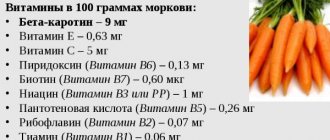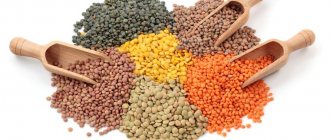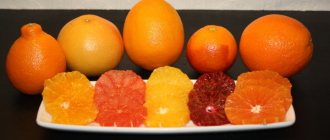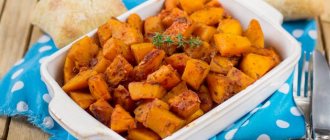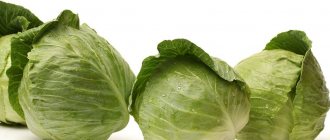Store shelves are lined with packages of dozens of varieties of rice [1]. It differs in shape, size, color and, accordingly, structure and taste. One of the varieties of aromatic rice is basmati with characteristic small oblong grains and a yellowish tint. Traditionally, basmati is produced in the countries of the Indian subcontinent, and its largest supplier is India.
What do you need to know about Indian basmati, are there any contraindications for the product, and what happens to the body with long-term consumption of rice?
general characteristics
Basmati is an aromatic rice variety. Jasmine and dozens of hybrid varieties also belong to this group. There is no single specific criterion by which rice could be classified as a basmati variety. The product is evaluated based on the totality of its properties and characteristics [2].
Content:
- general characteristics
- Brief historical background
- Useful properties of the product
- Chemical composition of the product
- Dangerous properties and possible harm of rice
- Use of rice in cooking
- Features of industrial production
- The problem of falsification
Authentic Indian Basmati is a harmonious combination of shape, size, intense aroma and texture. The length of the grain varies depending on the variety, but does not exceed 7 millimeters. The grain is thin, oblong, slightly curled at the end. Its shape is very similar to the Turkish dagger.
Indians prefer basmati over other varieties of rice for its taste and significant increase in volume when cooked.
During heat treatment, the volume of basmati doubles. This occurs due to an increase in the thickness and length of the grain. Keep this in mind when cooking so as not to overdo it with portion sizes. The boiled product has a sweetish taste and a subtle nutty aroma. If the rules for preparing the product have been followed correctly, the rice will be dry, crumbly and dense.
The taste characteristics of rice improve over time. It is believed that rice should ripen on its own within a year. The ripening period for higher varieties increases to 10 years.
Useful tips and tricks
Basmati cooking tips shared by professionals:
- You can only get fluffy rice if you wash it first and boil it until half cooked, using a liquid ratio of 1:1.5, and then let it brew.
- You should always check the quality of cereal before cooking and buy only a product from a trusted manufacturer.
- When pre-soaking grains, it is necessary to further reduce the amount of water for boiling.
To cook Basmati rice, thick-walled dishes are required so that the grains will not stick or burn during cooking.
Brief historical background
The term "basmati" is translated from Hindi as "fragrant". Historians say that rice cultivation in the Indian subcontinent began more than 3 thousand years ago. The first mention of the product is found in the poem “Heer Ranjha”. This is one of the popular Indian tragic works, which was written in 1766.
Initially, “basmati” was used to refer to absolutely all varieties of aromatic rice. Over time, this trend began to decline, and the term began to be applied only to a product of special quality.
Thanks to the light hand of Indian traders, the aromatic product was seen by the whole world. The spread began in the Middle East. The locals liked the basmati so much that they decided to resell it for additional profit. Gradually, basmati gained popularity and became the basis for Persian, Arabic and other Middle Eastern culinary traditions.
Today, rice is used in every gastronomic culture in the world. It is served with a variety of side dishes and combined with special herbs and spices, which favorably highlight its taste and aromatic composition. The dish is common among both street junk food and Michelin-starred restaurants, so every consumer will find a suitable variation to suit their own taste.
Calorie content of cereals and weight loss methods
The calorie content of red rice is 300-340 kcal per 100 grams of dry product. Unlike ordinary rice, this calorie content is much lower, so rice can be used for weight loss. It is worth considering its nutritional value in more detail:
| Elements | |
| Squirrels | 6,8 |
| Fats | 0,57 |
| Carbohydrates | 63,8 |
Based on these numbers, we can say that red rice is an excellent option for weight loss. It is moderately nutritious and contains the right amount of proteins, minerals and trace elements to balance metabolism. At the same time, it will quickly remove unnecessary salts and toxins from the body.
Red rice can be used as a food for a fasting day or a diet for 7 days. It is enough to boil the rice without adding spices and eat it throughout the day. You can drink purified water without gas, unsweetened green tea.
The advantage of this diet is that rice provides a certain boost of energy and the required amount of essential substances for the body. Before starting a diet, you should still consult a gynecologist, since each human body is individual!
Useful properties of the product
Rice contains a lot of fiber. This is the rough part of the plant that is not digestible by the human body. It is the inability to digest fiber that determines its benefits and important role in the human diet. Basmati contains soluble fiber. After entering the body, it turns into a liquid gel that envelops the internal organs and improves their functionality.
What else is this substance useful for:
- reduces the concentration of glucose in the blood, prevents sudden surges in sugar after meals;
- regulates the level of “bad” cholesterol, thereby reducing the risk of developing heart and vascular diseases;
- improves bowel function and solves problems with irregular or painful stools;
- promotes long-term saturation and the formation of powerful energy potential, which protects against overeating and helps to lose weight;
- harmonizes internal microflora and improves skin condition;
- protects the body from the development of breast cancer and intestinal cancer;
- nourishes the internal microbiome, which contributes to high-quality human life.
The content of vital amino acids in basmati is several times higher than in other varieties of rice. This product is a leader in the concentration of iron, phosphorus, potassium and vitamins. Moreover, basmati contains a minimal amount of sodium, which helps maintain a normal potassium-sodium balance.
A high-quality product gently envelops the stomach, is easily digestible and does not create a significant burden on the digestive tract. Another benefit is its lower glycemic index [3]. After a serving of rice, the product is slowly released into the blood, and the sugar level remains normal. This GI provides long-term satiety, reduced cravings for sweets and a feeling of lightness until the next meal.
Chemical composition of the product
Energy value (per 100 grams) [4]
| Calorie content | 370 kcal |
| Squirrels | 7.94 g |
| Fats | 2.92 g |
| Carbohydrates | 77.24 g |
| Alimentary fiber | 3.5 g |
| Water | 10.37 g |
Vitamin composition (in milligrams per 100 grams)
| Thiamine (B1) | 0,401 |
| Riboflavin (B2) | 0,093 |
| Pantothenic acid (B5) | 1,493 |
| Pyridoxine (B6) | 0,509 |
| Folic acid (B9) | 0,02 |
| Tocopherol (E) | 1,2 |
| Phylloquinone (K) | 0,0019 |
Nutrient composition (in milligrams per 100 grams)
| Calcium (Ca) | 23 |
| Magnesium (Mg) | 143 |
| Sodium (Na) | 7 |
| Potassium (K) | 223 |
| Phosphorus (P) | 333 |
| Iron (Fe) | 1,47 |
| Zinc (Zn) | 2,02 |
| Copper (Cu) | 0,277 |
| Manganese (Mn) | 3,743 |
With vegetables in a slow cooker
In a slow cooker you will get a tasty, healthy, dietary dish.
Ingredients:
- Basmati rice – 2.5 multi-cups;
- water – 5 multi-glasses;
- corn - can;
- olive oil;
- turmeric – 0.5 teaspoon;
- carrot – 1 pc.;
- paprika – 0.5 teaspoon;
- onion – 1 pc.;
- green peas - 0.5 cups;
- bell pepper – 1 pc.
Dangerous properties and possible harm of rice
The high amylase content in rice can lead to intestinal dysfunction and colic. Moreover, nutritionists say that eating rice is one of the causes of obesity. Do not overuse basmati to avoid these unpleasant consequences.
People with individual intolerance and children under 3 years of age should completely avoid the product.
Scientists have found a direct link between rice consumption and an increased risk of diabetes [5]. Nutritionists still cannot come to a consensus regarding the benefits and harms of this product. Some consider rice a safe starch, while others consider it a source of empty carbohydrates.
For 20 years, scientists conducted a study in which more than 350,000 subjects took part. As a result, it became possible to draw a parallel between the consumption of basmati and the development of diabetes. The risk level increases by 1.5%, which is a very significant indicator.
How to protect yourself? Scientists recommend eating more brown rice and combining it with the usual white rice. You need to add at least 100 grams of vegetables to each dish to balance your diet and get the required amount of nutrients. The main thing is that the daily BJU is balanced, and in the usual rhythm of life there is time for your favorite physical activity. Then the risk of disease is reduced to a minimum.
How to cook and serve
Before cooking, rice must be washed . The water in the bowl with cereal should become completely clear. You can also soak it in cold water for 15-20 minutes. Basmati takes the same amount of time to cook as regular rice - about 15 minutes. It is advisable not to cook it, but to simmer it under a closed lid in a small amount of water.
Important! Basmati is not used to make thick milk porridge; it is too crumbly for it.
What is Pakistani rice good for? It is usually combined with turmeric, cumin, lemon juice, cilantro, mung bean, coconut and sesame oil . Let's look at three recipes for delicious dishes.
Shepherd's Pie
This is a traditional Scottish dish . Initially, the recipe included potatoes and lamb. Now there are various variations of preparation. One of them is with Basmati rice.
Ingredients:
- 3 cups boiled rice;
- 1 carrot;
- 1 onion;
- 3/4 cup green peas;
- 2 tsp. vegetable oil;
- 450 g ground beef or lamb;
- 150 ml meat broth;
- 1 tbsp. l. tomato paste;
- 1 tbsp. l. Worcestershire sauce;
- 1 egg;
- 70 g Cheddar cheese;
- 1/2 cup sour cream;
- salt.
Preparation:
- Pre-defrost the minced meat and allow excess liquid to drain. It is better to use freshly prepared or chilled.
- Preheat the oven to 220 degrees.
- At this time, peel and rinse the green peas.
- Peel the onion and finely chop it.
- Peel the carrots and cut into pea-sized cubes.
- Pour oil into the frying pan. Fry the onion until transparent.
- Add minced meat and fry for a few minutes.
- Pour in meat broth, tomato paste and Worcestershire sauce. Add salt and pepper to taste.
- Mix everything thoroughly and simmer for 5 minutes after boiling.
- Add peas and carrots to the pan. Cook for a couple of minutes.
- In a separate bowl, mix egg, sour cream, boiled rice and grated cheese.
- Grease a baking dish with oil.
- First add the minced meat with vegetables. Place rice evenly on top.
- Place in the oven for 8-10 minutes until a crust appears on the rice.
- Serve the dish in a baking dish, sprinkle with fresh herbs.
Use of rice in cooking
Basmati has a specific spicy aroma and nutty flavor palette. This is explained by the high content of the chemical compound 2-acetyl-1-pyrroline. A similar compound is found in pandan leaves, which are dried and used as a spice. The same cyclic compound is found in cheese, fruits and most cereals. On an industrial scale, it is used to impart a specific aroma to baked goods.
Basmati grains contain a minimal concentration of gluten (gluten), due to which the rice grains are easily washed and separated from each other without effort.
The product can be subjected to all types of heat treatment, but steam is considered the most successful in terms of taste and benefits.
How to cook the product correctly
Pour the rice into a container and rinse 3 to 7 times (pay attention to the degree of turbidity and the shade of the water). If you cook unwashed rice, the result will be a sticky texture and an unnatural taste.
Prepare a saucepan with a thick bottom, pour water into it at the rate of 2 cups of liquid per 1 cup of rice. Place the washed basmati into boiling water. You can first add salt and your favorite spices to the liquid.
Set the heat to maximum and cook the rice for 4 minutes. Then reduce the heat to medium and cook for another 4 minutes. At the last stage, reduce the heat to low and cook the cereal for another 4 minutes.
Remove the finished basmati from the stove, cover with a lid and leave for at least 10 minutes. Rice must independently “reach” the desired taste and structure. Before serving, thoroughly stir the contents of the pan. Basmati should be combined with other components of the dish immediately before serving.
Composition of basmati rice
The product is most suitable for preparing light side dishes and pilaf. Although basmati rice is high in calories, it is considered a dietary food because it contains a small amount of starch compared to regular round rice. But excessive consumption of the product can cause obesity.
Basmati rice contains:
- folic acid;
- thiamine;
- phosphorus;
- amino acids;
- sodium;
- potassium;
- cellulose;
- iron.
It is very easily digestible and provides the body with the daily requirement of carbohydrates. Very useful for athletes and should always be in their diet, especially white. Compared to baked goods and pasta, it is a hassle-free, easily digestible carbohydrate food. Pairs well with protein foods, as well as vegetables and meat. Fragrant boiled basmati rice with vegetables is a wonderful dish for those who fast or share the principles of vegetarianism.
Features of industrial production
Traditional producers and exporters of basmati are India and Pakistan [6]. The total volume of harvested crops in both countries amounts to tens of millions of tons. Outside of Pakistan and India, there are only local rice farms that work with private entrepreneurs, filling a minimal percentage of the world's turnover.
Producing high-quality traditional basmati requires a lot of effort and material expenditure. Moreover, this particular rice is considered the most popular among consumers, so the efforts of large concerns are paying off. The cost of basmati is much higher than any other aromatic rice, but its nutritional/taste properties are also different.
Traditional basmati varieties produce minimal yields. Most crops are subject to attacks by pests and diseases, so many hybrid varieties with the most favorable parameters have been created [7]. To get a high yield from a traditional variety, you will have to strictly adhere to the sowing/transplanting dates and carefully select the region where the crop is grown. The culinary properties of the product depend on:
- method of transplantation;
- density of planted plants;
- the period of disembarkation and transplantation;
- storage conditions for collected grain;
- harvest time interval.
Successful cultivation of the crop is possible only under certain conditions. During the growth period, the plant requires high humidity (80%) and temperatures ranging from 25 to 35°C. Additionally, you need to provide rice with irrigation, drainage and neutral soil. Moderate humidity, warm weather and little wind are the key to a bountiful harvest that will delight you with a pleasant taste and aroma.
Best materials of the month
- Coronaviruses: SARS-CoV-2 (COVID-19)
- Antibiotics for the prevention and treatment of COVID-19: how effective are they?
- The most common "office" diseases
- Does vodka kill coronavirus?
- How to stay alive on our roads?
Rice is a light-sensitive crop. The formation of flowers and ripening of rice begins in the short daylight stage. This does not always have a positive effect on the quality of the crop and the nutritional properties of the cereal. To reduce photosensitivity, agronomists have developed several hybrid varieties of basmati, which are used in equal quantities with traditional ones.
By the end of the twentieth century, three hybrid varieties entered the market, which were not inferior to real basmati in taste and quality. The yield of these varieties was 4.5 tons per hectare of land versus 2.5 tons. High yields, resistance to diseases/pests and identical taste won over producers and consumers, and hybrid varieties reached the peak of popularity [8]. Due to them, it was possible to slightly reduce the cost of the finished product and increase sales volumes.
Variety of varieties
There are about 150 varieties of rice, each of which has a unique taste and aroma. Let's talk about the most common varieties that are used for cooking in different countries.
Basmati. The Hindi word for this word means “fragrant”. Elite rice grown in India and Pakistan has a refined nutty aroma and pleasant taste. The grains of the longest rice in the world can increase up to 2 cm when cooked, but the width remains virtually unchanged. Basmati is considered an ideal side dish for any dish; it makes delicious pilaf and risotto.
Jasmine. This variety of rice is grown in Thailand and has a pleasant aroma reminiscent of jasmine. Snow-white rice turns out to be very tender and soft, but at the same time its long grains do not boil over and retain their shape. Jasmine rice can be used in salads, side dishes and desserts.
Red rice Interestingly, in France, where this rice grows, it was considered a weed for a long time. In Asia, red rice has been known for a long time and is considered one of the healthiest and most nutritious. It does not become overcooked and at the end of cooking it acquires a delicate nutty aroma. Salads, side dishes and traditional Iranian pilaf plau akhmar are prepared from red rice.
Wild rice. Once the only food of the American Indians, it is now grown in the northern United States. Wild rice, which has long black grains, is a record holder for the content of vitamins and microelements. Due to the high hardness of the grains, they should be boiled for 30 minutes to an hour with preliminary soaking.
Black Tibetan rice. Grown in the highlands of Tibet and harvested entirely by hand. This rare, expensive, beet-purple rice was previously only available to wealthy people. It contains twice the protein, cooks for 40 minutes and is used in salads and side dishes.
Arborio. Italian medium grain rice has one amazing property - when cooked, it acquires a creamy consistency and absorbs the taste and aroma of all the ingredients of the dish. Traditionally, arborio is used to prepare soups, paella and risotto - its softness and tenderness are ideal for these dishes. For risotto, you can also buy Roma, Carnaroli, Baldo, Padano and Vialone nano varieties.
Camolino. Large and round grains of Egyptian rice are pre-treated with vegetable oil, so they acquire a pearly creamy hue. After cooking, rice retains its softness and stickiness, but the grains do not stick together. Camolino is used to make sushi, porridge and delicate desserts.
Spanish rice Particularly good varieties are bomba, valencia and calasparra of medium or short length, which do not stick together when cooked. Rice absorbs liquid perfectly and remains crumbly. Spanish rice makes delicious pilaf and paella.
Krasnodar rice. This short-grain rice is considered the most northern in the whole world. It has a classic taste and is used to make soups, sushi, puddings and porridges.
Uzbek rice for pilaf. The legendary varieties chungar, devzira and dastar-saryk seem to be created for real Asian pilaf. Thick and heavy grains of cream, brown and reddish color, thanks to special processing, absorb the maximum amount of moisture and fat, which makes the taste of the dish especially piquant. The finished rice is light, crumbly and slightly sweet in taste.


